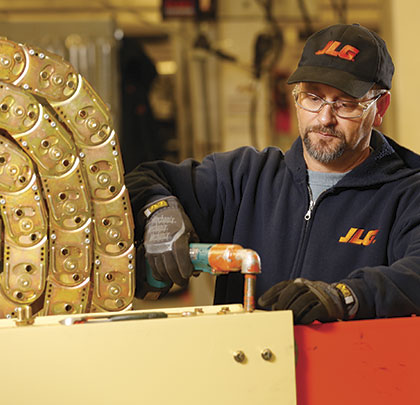Whether updating your fleet or expanding it, reconditioning your own equipment or purchasing reconditioned equipment may be an affordable option to ensure your fleet is up to the tasks before you.
WHAT HAPPENS TO RECONDITIONED EQUIPMENT?
If you’re looking for “like new” equipment, how do you know the machine you’re interested in is truly restored to its new condition? Begin by asking whether the machine was reconditioned by an original equipment manufacturer (OEM) and what the scope of work is included. The best factory reconditioning programs include a rigorous process that performs a complete tear down of the machine and looks at four major systems: electrical, hydraulic, drive train, and structural components. Boom structures should also be completely disassembled and engines removed, evaluated, and resealed or rebuilt.
A comprehensive reconditioning program also evaluates an extensive list of other components—such as batteries, cables, chains, alarms, filters, hoses, cylinders, transmissions, axles, and brakes—and adjusts, reseals, or replaces them. Replacing them with OEM parts ensures that the components are factory-approved. Seat and seat belts should also be restored or replaced, along with the steering wheel and horn button, wear pads, chains, sheaves, fork bars and forks, pins and bushings, mirrors, mufflers and exhaust pipes, bellows and knobs on controllers, tires, and fiberglass hoods.
Additionally, the provider should perform an oil analysis and cooling system flush and fill. Finally, the machine should be blasted to remove old paint before recoating and reassembling.
Once the reconditioning work is completed, the provider should test the reconditioned machine to the OEM’s equipment standards to ensure the equipment meets the same quality standards as when the unit was originally built. It is also important to know whether the machine comes with a warranty and what the warranty covers.
QUESTIONS TO ASK THE SELLER
Understanding the vendor’s process and the standards the machine meets should help you decide if the machine is worth the purchase price. Other questions to ask include:
- Can the seller supply references of other customers who have purchased a reconditioned unit?
- Does the seller provide aftersales support?
- What can you expect in terms of life expectancy from the machine?
- Is a history of the machine available? If not, can the seller describe anything unusual that was discovered during the reconditioning process?
- Can you test drive the machine?
WHEN DOES IT MAKE SENSE TO RECONDITION YOUR EQUIPMENT?
If, rather than buying a reconditioned machine, you are thinking about having a piece of equipment you own reconditioned, it is important to know when it makes the most sense to do so. Reconditioning is typically less expensive than purchasing new. Depending on the equipment, an owner may be able to recondition two assets for the same price as buying one new machine, doubling the return on investment.
It’s important to note that despite new Tier 4 standards, Tier 2 and Tier 3 engines rebuilt as part of a reconditioning process need only meet industry standards to which they were originally built. This allows the owner to stay compliant while holding on to equipment longer, maximizing their investment.
Reconditioning can also be considered a “green” alternative to disposing of a machine. It reduces the amount of material destined for landfills, and reconditioning saves 12 tons of steel, water, and other resources compared to manufacturing a new unit.
However, you should know that not every boom or telehandler is a good candidate for reconditioning. Although it is true that an OEM should be able to rebuild a piece of equipment from the ground up and restore it to “like new” condition, it’s not always practical. Major structural damage or other problems may make repairs too costly. That’s why a good reconditioning program involves two levels of inspection. The first begins with a thorough inspection of the frame and all readily visible components. A second inspection after teardown completes the view to all needed repairs. Armed with this information, owners can make informed decisions on whether reconditioning makes sense.
CERTIFIED USED EQUIPMENT IS ANOTHER OPTION
If reconditioning or purchasing reconditioned equipment is not an option, consider purchasing certified pre-owned equipment. Although the scope of work may not be as extensive as it is for reconditioned equipment, you can still find OEMs that offer rigorous 125-point boom inspections, 80-point telehandler inspections, 2-year parts and labor warranties, and annual inspections. In some cases, financing options are also available.
OEMs that take advantage of ecommerce can make the search for both certified pre-owned and reconditioned equipment as easy as entering information on your computer. For example, last year JLG launched a website where users can find, inspect, and buy quality pre-owned construction equipment from JLG. The website features a wide variety of brands and machine types, as well as JLG factory-reconditioned machines and certified pre-owned machines. Payment options include credit card, Automated Clearing House (ACH), and financing. Users can even arrange and pay for shipping their purchase. If users do not find a specific make or model, they can create a personal wish list online, and JLG will work to source it for them. Users will be able to search by customizable criteria, view product photos, and review all features and specifications. The website is also optimized for use on mobile devices for added convenience.
Managing a fleet so that it operates efficiently and keeps your operators happy can be a challenge. Purchasing reconditioned equipment can help, especially in the current economy, but only if you understand and trust the scope of work performed on the machine, the warranty that stands behind it, and the reputation of the vendor selling it to you. ■
About the Author: Christopher Mellott is vice president of aftermarket sales at JLG Industries, Inc. In this role, Christopher is responsible for revenues in the Americas, including parts, used equipment, and reconditioning. For more information, visit www.jlgused.com.
_________________________________________________________________________
Modern Contractor Solutions – May 2016
Did you enjoy this article?
Subscribe to the FREE Digital Edition of Modern Contractor Solutions magazine.



